Paul Vernon H.,
Bryan Bartlett S.
(and Friend)
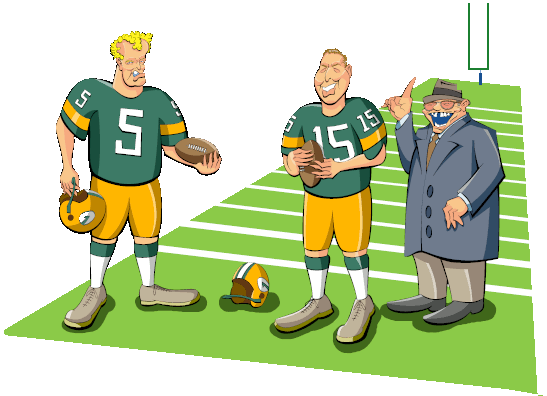
(Click on the image to zoom in and out.)
| "Now that kid Bart Starr, he's your quarterback." | |
| ‐ | Ernest Borgnine, 1973 |
| "At that time the opinion around here [in Green Bay] and in fact the opinion in the league was that Starr would never make it. They said he couldn't throw well enough and he wasn't tough enough and that he had no confidence in himself and that no one had any confidence in him." | |
| ‐ | Vince Lombardi, 1964 |
Hm. There seems to be a bit of a discrepancy in what Ernest Borgnine said while playing the role of Vince Lombardi in the TV movie Portrait: Legend in Granite and what  The Real Vince Lombardi thought when he first took the job as the Packers head coach. In the movie Ernest - or the scriptwriters - immediately decided Bryan Bartlett Starr was going to be what is now called the "franchise" quarterback at Green Bay.1
The Real Vince Lombardi thought when he first took the job as the Packers head coach. In the movie Ernest - or the scriptwriters - immediately decided Bryan Bartlett Starr was going to be what is now called the "franchise" quarterback at Green Bay.1
Footnote
The term "franchise quarterback" is bandied about today with much aplomb even though no one seems to know exactly what it means. You would think that since an NFL franchise is NFL team located in a particularly city, it seems that a franchise quarterback would be the quarterback playing for an NFL franchise.
However, the term first shows up around 1990 and began to move into common parlance only after the turn of the Millennium. The meaning then was more or less that of an "elite" quarterback. But it also has the connotation that the team was going to stick with the player as their starter for some ill-defined length of time.
So sadly we must conclude that the scene where Ernest (ergo, Vince) was talking to the team's president, Dom Olejnickzak (played by John McLiam) was a scriptwriter's invention. In the scene Dom told Vince that he believed Paul Vernon Hornung - called "The Golden Boy" by the press - would develop into a top quality quarterback. This was immediately pooh-poohed by Vince (Ernest) who said "Hornung's no quarterback! He can't throw the ball that well. What he does do is run, block, and kick. That man's a half-back!"
The  TRUTH, though, is that as soon as the real Paul showed up at his first training camp in 1957, a full two years before Vince came in, it was clear that the former Heisman winning quarterback from Notre Dame was not going to be a success at his old college position. So the team had been trying hard to figure out what the hey to do with the player who was taking in one of the highest salaries in the league when he obviously wouldn't be playing what they had hired him for. For his part Paul had become so discouraged that he was considering getting out of professional football altogether and becoming a businessman.
TRUTH, though, is that as soon as the real Paul showed up at his first training camp in 1957, a full two years before Vince came in, it was clear that the former Heisman winning quarterback from Notre Dame was not going to be a success at his old college position. So the team had been trying hard to figure out what the hey to do with the player who was taking in one of the highest salaries in the league when he obviously wouldn't be playing what they had hired him for. For his part Paul had become so discouraged that he was considering getting out of professional football altogether and becoming a businessman.
As for Bart, the coaches and team executives weren't sure what to do with him either. Although he'd been on the team since 1956, the consensus was indeed that Bart wouldn't make it in the tough NFL. His college play at Alabama had been satisfactory but not distinguished,2 and the Packers had waited until the 17th round of the NFL draft to pick him up - #200 overall. So when Vince arrived in Green Bay, he stuck with the starter, Lamar McHan, and only went with Bart after Lamar was injured.
Footnote
Bart's college career had been hampered by a back problem which was usually attributed to an injury incurred while punting a football. But after Bart died in 2019, his wife stated that the injury had been due a hazing incident. This rather sordid account was confirmed by a fellow teammate.
Actually, Portrait: Legend in Granite was not that bad as TV movies go. It told the truth mainly (to quote Mark Twain), and one plus for the show was that Ernest Borgnine was the veritable image of Vincent Thomas Lombardi. Other roles were filled by John Calvin playing Paul Hornung, James Olsen as Max McGee, and Milt Kogan assuming the role of Ray Nitschke.
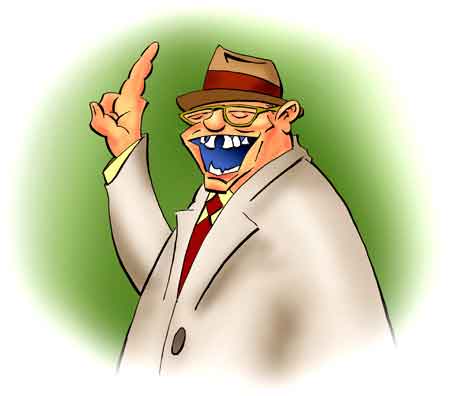
Vince Lombardi
(Or is it Ernest?)
But the only times you saw Bart Starr in the movie was in film clips from the real games. What, you ask, was the Beef About Bart?
The obvious answer is that there just weren't enough actors who looked like Bart. But for some connoisseurs of docudramas, this explanation may seem a bit simplistic. After all, in the 1963 movie PT-109 the 39-year old Cliff Robertson certainly didn't look much like - nor sound like - a 26 year old John Fitzgerald Kennedy. And even though John Calvin was a pretty good Paul Hornung, did James Olson really look that much like Max? And even when Milt Kogan's visage was partially obscured with the trademark Nitschkean horn rimmed spectacles, he didn't really look that much like Ray.
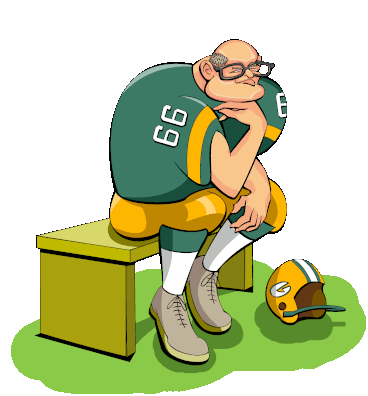
Ray Nitschke
Not much like Milt.
(Click to zoom in and out.)
When the movie was broadcast, Paul and Max had been retired for several years and to be frank, they were fading from the Collective American Consciousness. True, Paul was providing commentary for the Minnesota Vikings but he was not getting widespread national attention. For his part, Max had become an entrepreneur in the restaurant business, and although Ray attended the Green Bay training camp in 1973, he retired before the season began. He remained a popular figure as a Green Bay businessman, but pretty much shied from national celebrity.
But in 1973 Bart was still active in football. Although he had retired as the Green Bay quarterback two years before, he had become the team's quarterback coach and in 1975 he was hired as the Packers head coach, a tenure he held until 1983. Bart was even appearing on television commercials for crying out loud! So we again fall back on the answer that there just weren't many actors that looked enough like Bart to be believable.3
Footnote
Today it certainly seems that actual resemblance between an actor and the person they're portraying is of trivial importance. You'll find lists of actors, even after availing themselves to the considerable technology wielded by the Hollywood makeup departments, who bore scant likeness to the characters they portrayed. These include Hugh Jackman as P.T. Barnum, Leonardo DiCaprio as J. Edgar Hoover, Jon Voight as Howard Cosell (!), and Michael Shannon playing Elvis. This apparent unwillingness to craft a resemblance is decidedly odd since today Hollywood make-up artists with their arsenal of prosthetics can make anyone look like anyone else. They can even make humans look like talking gorillas, for heaven's sake!
Part of the problem is that if a movie character is a historical figure - yes, Elvis is a historical figure - you want at least some semblance with the actual person. But at the same time the fans want to be able to recognize their favorite actors as well. After all, would anyone really wanted to see J. Edgar if Leonardo DiCaprio really did look like J. Edgar Hoover?
Not, as Eliza Doolittle said, bloody likely.
The real irony is that if the film had come out earlier it wouldn't have mattered since even well into the television age most people didn't recognize professional football players anyway. After all, when both Frank Gifford and Ray Nitschke made their separate appearances on the celebrity panel quiz show What's My Line, no one recognized them.
And this was when Frank was the star halfback for the New York Giants and the year he was voted the NFL's Most Valuable Player! And the panel members were New Yorkers for Pete's sake!
Now it was true that Frank threw the panel a curve by signing in as "F. Newton Gifford". But that was 1956 - a most different era. If today someone couldn't recognize a star gridiron player - and the NFL's MVP - you'd ask what planet they were from. Ray, wearing his glasses, was on the show even later - December 30, 1962. Ray was Green Bay's star linebacker and had just been voted the MVP of the recent NFL Championship Game.
And to rub even more salt into the wounds of early pro-football anonymity, the Giants head coach of the time was Jim Lee Howell. In 1957, he was a spurious contestant on To Tell the Truth - and no one recognized him, either. And we're talking about the head coach of the then NFL Champions!
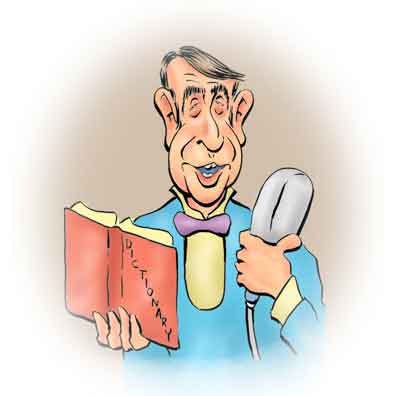
Howard Cosell
Broadcasting with Frank and Don.
With the Mystery of the Missing Bart (maybe) solved, there remains the Last Great Mystery of the Universe. And that's just what caused football to change from a game where the greatest athlete of the 20th century was making a paltry $6000 a year when he played for the Giants into a business where the players' salaries practically drive the national economy? Or perhaps in a less mercenary tone, what made football so popular in the few short years from 1955 to 1965?
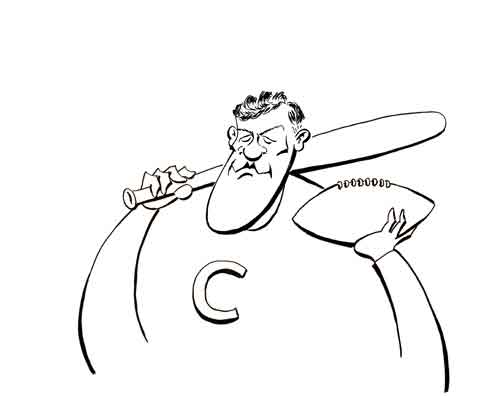
Jim Thorpe
The Greatest Athlete at $6000 a year.
In the first half of the 20th Century, there were only three professional sports to speak of: boxing, horse racing, and baseball. But horse racing and boxing had a whiff of disrepute about them. Horse racing was closely tied with gambling and as it is today. Although today you'll have churches sponsor gambling junkets to the local casinos, in the early 20th Century gambling was considered something that "good people" didn't do. But you can't really enjoy horse racing without laying a wager.
Boxing, too, was a betting sport but was also associated with the rough crowd. Although heavyweight champions like Jack Dempsey attained national celebrity and there were local athletic clubs that would sponsor amateur matches, boxing was not a career path that most parents hoped for their sons.

Jack Dempsey
National Celebrity
(Click on image to zoom in and out.)
Instead it was professional baseball that was the national pastime. A little mature reflection will reveal why. For one thing, it was a game everyone could play. The communities gathered into organized leagues and sometimes grownups picked up a bit of change as "semi-pros." So those with talent found plenty of opportunity to hone their skills on the way to the pros. There were even teams for the ladies.
But professional football was a non-entity. Fans were few. After all, who wanted to gather along the sidelines of a cow pasture to watch a bunch of ham-fisted palookas run from one end of the field to another? As a spectator sport it was definitely a sidelined activity.
That is, professional football was a sidelined activity. But football had been major entertainment stretching back to the days of Queen Victoria.
College football, that is. In fact to the American public college football was a close second to baseball. Even when pro-games began to be broadcast, it was usual for the announcers to mention the player's college almost as a third name. They'd say things like "It's a screen pass from Joe Blow, the quarterback from Auburn, to John Doe, the flanker from SMU, assisted by a great block from Richard Roe, the fullback from Wake Forest."
So what happened?
One American historian has pointed out that complex processes have complex explanations and that's certainly true as to why professional football finally overtook baseball in the popular fancy. Listing the reasons why would merit an essay in itself, but certainly among the catholicity of contributing causes was the meteoric rise of Coach Vincent Thomas Lombardi.
You see, in 1958 Vince was an aging and largely unknown assistant coach for the New York Giants. But in three years he had become a national figure who had taken the Green Bay Packers to the NFL Championship after they defeated the apparently unbeatable New York Giants, Vince's old team, 37-0.
Before Vince arrived at Green Bay, Wisconsin, the town was known mostly for its snowy winters, having plenty of booze during Prohibition, and being one of the largest toilet paper manufacturers of the world. Green Bay was even the first town where Charmin was manufactured even though eventually Mr. Whipple squeezed it over to Mehoopany, Pennsylvania.
Oh, yes. And Green Bay was the home of the rottenest football team around. Every year from 1948 through 1958 they had a losing season and in 1958 they had outdone themselves with a 1-10-1 record.
Then Vince showed up. In his first meeting with the players, he told the team he had never been associated with a losing football team. That was true enough. And he said he wasn't going to start now. And that was also true enough.
At the same time the players didn't quite know what to make of a man whose only head coaching experience had been at St. Cecilia High School in Englewood, New Jersey. From 1935 to 1944 he had coached the team where he also showed his incredible mental facility by teaching chemistry. Vince had then moved on to be an assistant coach at Fordham University, the Jesuit college where Edgar Allan Poe used to spend his Sunday afternoons playing cards and drinking with the priests. Two years later Vince was hired as an assistant to West Point head coach Red Blaik. Then in 1954 he moved on to the pros to become offensive coordinator for Jim Howell for the Giants.
In many ways, being hired by the Giants was a disappointment. Vince was in his forties and old for an assistant coach. In fact, he had thought he was in line to be the head coach. And truth to tell Vince didn't get off to a great start even as an assistant. In high school and college the coach knows more about playing the positions than the kids and can tell them what to do. But professional players already know what they're doing and many have enough knowledge of the other positions to be coaches themselves.
But the New York players thought Vince was acting like he was still coaching in high school. He'd get up and start to teach them how to run a play which worked in high school and college but wouldn't in the pros and on that team. Besides, they had known how to run the plays for years. And it was comical the way he would rant and rave and make an erring player take a lap round the field. That was kids stuff.
The players would laugh at their rookie coach and figured he'd be gone before long. They even made him the butt of their hoorawing. One of their favorite tricks was to hide the chalk when Vince was about to diagram a play and then laugh when he went ballistic. "We didn't dislike him or anything," said Frank Gifford. "We just thought he was kind of weird."
Vince quickly realized he wasn't connecting with the players and went to both Frank and the starting quarterback Charlie Conerly and asked them what he was doing wrong. They told him that some of the plays he wanted to run weren't going to work with the players they had. Vince listened and soon the players were able to "straighten him out" to use a phrase popular among the follicularly sparse in the quaint regions of the American Southwest.
The men began to respect Vince as they realized he had undoubted ability. Vince also appreciated their toughness. Charlie, for one, didn't mind playing if he got hurt. In one game he broke his nose and stayed in the game although the trainers had to come out between plays and push his nose back in place.
For his part Jim Lee Howell took a hands-off approach with his coaching staff and Vince became the de factor head coach for the offense (a fellow named Tom Landry was coaching the defense). So when Green Bay began looking for a head coach, Vince was the prime candidate.

The construction worker from Pittsburgh.
(Click on image to zoom in and out.)
We said that Vince's rise was one factor in bumping up the pro football awareness in  . Of course, there were other things going on, too. During the time span that Vince was transitioning from assistant to head coach, the Baltimore Colts needed a back-up quarterback. So naturally they hired a construction worker for the job. And in addition to working construction, Johnny Unitas had been picking up $6 a game playing semi-pro in Pittsburgh's sand lots.
. Of course, there were other things going on, too. During the time span that Vince was transitioning from assistant to head coach, the Baltimore Colts needed a back-up quarterback. So naturally they hired a construction worker for the job. And in addition to working construction, Johnny Unitas had been picking up $6 a game playing semi-pro in Pittsburgh's sand lots.
From 1953 to 1956 the Baltimore Colts, like Green Bay, had not - as the businessmen say - met projected expectations. In those four years the team racked up a paltry 16-31-1 record. And John's start was a bit rough. The first pass he threw was an interception.4
Footnote
Despite John's iconic and even legendary status, when he first showed at Baltimore, no one even knew how to pronounced his name. The announcers might say "you-KNEE-tus" or "YOU-neh-tus". Finally they got it right at "you-NYE-tus".
But as far as being one of the top quarterbacks ever, people point out that today his statistics don't look that hot. John's overall completion rate was only 54.6 % and he's not even in the Top 20 for total passing yardage. True, he had 290 touchdown passes - respectable enough - but that's only #17 overall and he had also 253 interceptions which is a whopping 4.9%. His "quarterback rating" was 78.2, respectable yes, but later quarterbacks have racked up career ratings in the 80 percentiles and some reach to the 90's.
And if you really want to trash quarterback legends, look at Joe William Namath of the New York Jets, who was considered one of the top quarterbacks of the 60's and into the 70's. Joe Willie had a paltry 50.1 % completion rate and an abysmal quarterback passing rating of 65.5%!
More astonishing "Broadway Joe" had only 173 touchdown passes and - get this - 220 interceptions. Yes, one of the greatest quarterbacks in history had more interceptions than touchdown passes, for crying out loud!
Well, there are, as Mark Twain told us Benjamin Disraeli said, lies, damned lies, and statistics. Although you can lie quite nicely without statistics, thank you, the truth is some statistics are irrelevant to a particular discussion and that's certainly true when making historical comparisons.
In John's time quarterbacks ran the ball far more than they do today. It wasn't unusual for John to only attempt maybe 10-15 passes per game - we're talking 5 to 7 passes per half. Today you'll see quarterbacks tossing 40-50 passes in a game, for heaven's sake! Players also benefit from improved sports medicine and the public's insatiable appetite where if some sports is good, more is better, and too much is just enough. With longer careers, longer seasons, more games per season, and more teams in the league, naturally a lot of statistical markers will go up.
And once you make the needed corrections, John doesn't look that bad. Putting his touchdown passes as a percentage of total passes, John is close to the tops. He even edges out a recent quarterback who is considered perhaps the best in the game.
So what to do?
Perhaps quarterbacks should be rated by passing yardage per dollar. In 1956 Johnny Unitas made $7000 and threw for 1498 yards. So the Colts paid less than $5 per yard. Quite a bargain.
Then you have a more recent quarterback from a college from a Quaint University of the American Southwest who was picked #1. In his last season in the NFL he cost the team over $35,000 per yard - and the team ended up 3-13-0.
Give us Unitas!
But after the starting quarter back was injured, John took over, and Baltimore started winning games. From 1956 to 1960, Baltimore beat Green Bay. Yes, in Vince's first two years as head coach, Baltimore beat the Packers. But in 1961, Green Bay won.
At the end of the movie Vince had not told anyone of his decision to stay at Green Bay after the New York Giants asked him back as head coach. He did so in dramatic fashion and gave Ray (Milt) a verbal but good natured tweak of the nose.
As always there's a difference between the reel thing and the real thing. Since Vince was under contract he couldn't leave unless the Packers board of directors gave him the OK. But Jack Mara, the owner of the Giants, said that when he agreed to let Green Bay interview Vince it had been on the understanding that if Vince wanted to return to the Giants, he would be allowed to do so. On the other hand, Dom Olejniczak (still the Packers chairman and also the town's mayor), said he had no knowledge of any such agreement.
OK. Why did Vince stay? In the movie Vince (Ernest) told the team he was going to stick with Green Bay until they became champions. But Dom - the real Dom - said that he believed that if they had given Vince the OK, then he probably would have gone back to New York. And given that Vince had pulled Green Bay from the lowest rung in the NFL to one step from the championship, the team executives were loathe to let Vince leave. So at Green Bay he stayed.
Seeing the old films with Vince yelling at the guys and to hear them describe what they jokingly called his "constructive criticism" might give pause as to why many of the players stuck with Green Bay. But the players knew much of Vince's method was for effect, and he was once caught practicing his "tough coach" faces in a mirror. Still virtually all of the players held Vince in the highest regard. As linebacker Dave Robinson said, "He made you feel like a million bucks. He didn't pay you a million bucks. He just made you feel like a million bucks."
References
America's Quarterback: Bart Starr and the Rise of the National Football League, Keith Dunnavant, Thomas Dunne Books, 2011.
When Pride Still Mattered: A Life of Vince Lombardi, David Maraniss, Simon and Schuster, 1999.
Vince: A Personal Biography of Vincent Lombardi, Micheal O'Brien, William Morrow and Company, 1987.
Vince Lombardi, John Wukovits, Chealsea House Publishers, 1997.
"Hall of Fame QB Bart Starr Victim of 'Brutal' Hazing at Alabama", Tom Fornelli, CBS Sports, May 26, 2019.
The Whole Ten Yards, Frank Gifford, Random House, 1993.
"Actors Who Looked Nothing Like the Real-Life People They Played", Brendan Michael, Collider, July 2, 2019.
"Could There Be a Jim Thorpe Today?", Sean Cunningham, Inside Hook, May 29, 2018.
Portrait: Legend in Granite, Ernest Borgnine (actor), Colleen Dewhurst (actor), James Olson (actor), John Calvin (actor), John McLiam (actor), Alex Rocco (actor), Jack Smight (director), David Victor (producer), Groverton Productions, 1973.
Run To Daylight, Vince Lombardi (himself, author), Horace McMahon (narrator), Bart Starr (himself), Paul Hornung (himself), Jerry Kramer (himself), Ray Nitschke (himself), Jim Taylor (himself), Henry Jordon (himself), Forrest Gregg (himself), Tom Moore (himself), Willie Wood (himself), David "Hawg" Hanner (himself), Lou Volpicelli (director), W. C. Heinz (writer), Howard Cosell (producer), 1964.
A Man Named Lombardi, George C. Scott (narrator), Jerry Izenbert (writer and director), George Flynn (producer), Gould Entertainment, 1971.
Vince Lombardi: A Football Life, NFL Films, 2013.
Lombardi, John Facenda (narrator), Yoshio Kishi (writer, producer, director), Ed Sobol (executive director), NFL Films, 1968.
"What is a Franchise Quarterback Exactly?", Sam Snyder, Bleacher Report, July 30, 2009.
"The Streak That Changed Football", Sports Illustrated, December 10, 2010.
"Today's QBs Are Beyond Comparison", ESPN, Kevin Seifert, December 17, 2014.
"The Best Team You Ever Saw", Sports Illustrated, January 4, 1960.
"Vince Lombardi: What He Said to His Team and What They Said About Him", Evan Bleier, Inside Hook, January 28, 2019.
"Paul Hornung", The Heimsan Trophy.
"Which Team Attempted the Fewest Passes in an NFL Game?", Adam Schultz, SportsKeeda. December 8, 2021.
"Johnny U – Baltimore’s Most Important Player", Jim Johnson, Baltimore Sports and Life, September 14, 2021.
Huckleberry Finn, Charles L. Webster And Company, 1884
What's My Line?, John Daly (host), Frank Gifford (guest), Milton Berle (mystery guest), Bennett Cerf (panelist), Arlene Francis (panelist), Dorothy Kilgallen (guest), Stubby Kaye (panelist), CBS, December 2, 1956.
What's My Line?, John Daly (host), Ray Nitschke (guest), Vaughn Meader (mystery guest), Bennett Cerf (panelist), Arlene Francis (panelist), Dorothy Kilgallen (guest), Martin Gabel (panelist), CBS, December 30, 1957.
To Tell the Truth, Earl Crowder (contestant, Chief of the Texas Rangers), Jim Lee Howell (spurious contestant), Bud Collyer (host), Kitty Carlisle (panelist), Martin Gabel (panelist), Hy Gardner (panelist), Mary Healy (panelist), Frank Heller (director), CBS, April 30, 1957.
"Bart Starr", Pro Football Reference.
"Vince Lombardi", Pro Football Reference.
"Johnny Unitas", Pro Football Reference.
"Green Bay Packers", Pro Football Reference.
"Baltimore Colts", Pro Football Reference.
"Player X", Pro Football Reference.
"NFL", Ngram Viewer, Google Books.
"Franchise Quarterback", Ngram Viewer, Google Books.
"Where Does Charmin Come From?", Find Any Answer, June 2, 2019.
"Chapters from My Autobiography", Mark Twain, North American Review, 1907.
"The History of Ancient Rome", Garrett Fagan, The Teaching Company, 1999.